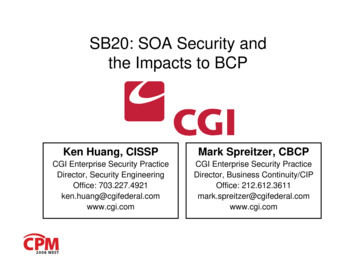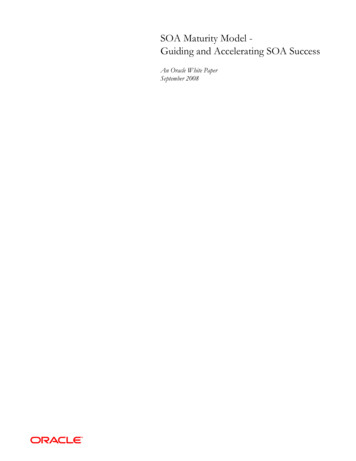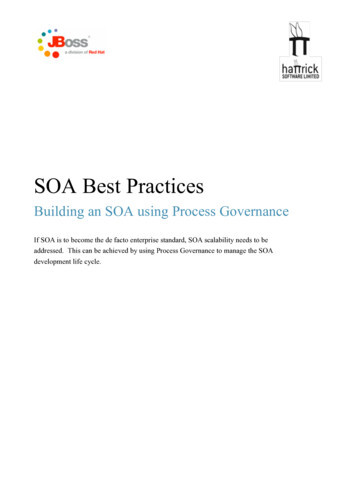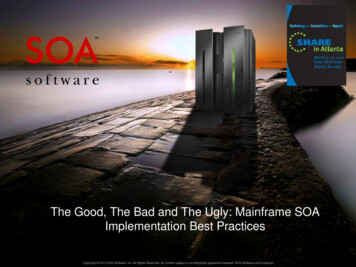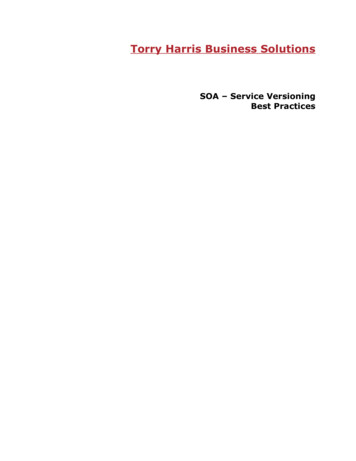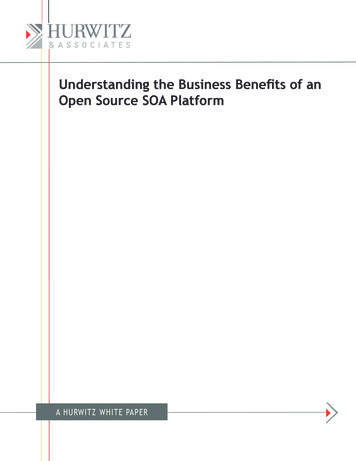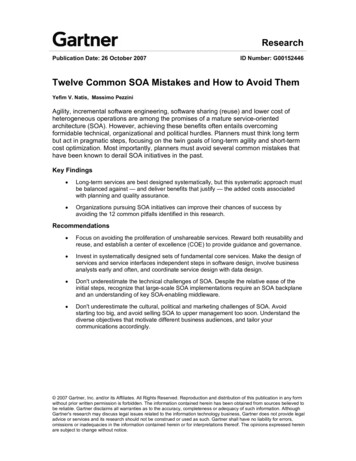
Transcription
ResearchPublication Date: 26 October 2007ID Number: G00152446Twelve Common SOA Mistakes and How to Avoid ThemYefim V. Natis, Massimo PezziniAgility, incremental software engineering, software sharing (reuse) and lower cost ofheterogeneous operations are among the promises of a mature service-orientedarchitecture (SOA). However, achieving these benefits often entails overcomingformidable technical, organizational and political hurdles. Planners must think long termbut act in pragmatic steps, focusing on the twin goals of long-term agility and short-termcost optimization. Most importantly, planners must avoid several common mistakes thathave been known to derail SOA initiatives in the past.Key Findings Long-term services are best designed systematically, but this systematic approach mustbe balanced against — and deliver benefits that justify — the added costs associatedwith planning and quality assurance. Organizations pursuing SOA initiatives can improve their chances of success byavoiding the 12 common pitfalls identified in this research.Recommendations Focus on avoiding the proliferation of unshareable services. Reward both reusability andreuse, and establish a center of excellence (COE) to provide guidance and governance. Invest in systematically designed sets of fundamental core services. Make the design ofservices and service interfaces independent steps in software design, involve businessanalysts early and often, and coordinate service design with data design. Don't underestimate the technical challenges of SOA. Despite the relative ease of theinitial steps, recognize that large-scale SOA implementations require an SOA backplaneand an understanding of key SOA-enabling middleware. Don't underestimate the cultural, political and marketing challenges of SOA. Avoidstarting too big, and avoid selling SOA to upper management too soon. Understand thediverse objectives that motivate different business audiences, and tailor yourcommunications accordingly. 2007 Gartner, Inc. and/or its Affiliates. All Rights Reserved. Reproduction and distribution of this publication in any formwithout prior written permission is forbidden. The information contained herein has been obtained from sources believed tobe reliable. Gartner disclaims all warranties as to the accuracy, completeness or adequacy of such information. AlthoughGartner's research may discuss legal issues related to the information technology business, Gartner does not provide legaladvice or services and its research should not be construed or used as such. Gartner shall have no liability for errors,omissions or inadequacies in the information contained herein or for interpretations thereof. The opinions expressed hereinare subject to change without notice.
TABLE OF CONTENTSAnalysis . 31.0 Introduction. 32.0 Two Critical Measures of SOA Success. 33.0 Twelve SOA Mistakes and How to Avoid Them. 43.1 Mistake No. 1: "Irrational SOA Exuberance" . 53.2 Mistake No. 2: Forgetting the Data. 63.3 Mistake No. 3: Leaving SOA to the "Techies". 73.4 Mistake No. 4: Succumbing to "Not Invented Here" Syndrome . 83.5 Danger No. 5: Starting too Big . 93.6 Mistake No. 6: Starting in the Wrong Place. 113.7 Mistake No. 7: Assuming That Everyone Thinks Like You . 123.8 Mistake No. 8: Choosing Dictatorship to Combat Anarchy . 133.9 Mistake No. 9: Underestimating the Technical Issues . 143.10 Mistake No. 10: Allowing Unshareable Services to Proliferate . 153.11 Mistake No. 11: Excessive Centralization . 163.12 Mistake No. 12: Selling SOA Before You're Ready. 184.0 Conclusions and Recommendations. 18Recommended Reading. 19LIST OF FIGURESFigure 1. Balancing Costs and Agility. 4Figure 2. Service Interfaces Should not Equal Software Interfaces. 5Figure 3. Degrees of Service-Data Normalization. 6Figure 4. The "Not Invented Here" Syndrome Is Contrary to SOA Principles. 9Figure 5. The Service-Oriented Application Enterprise . 10Figure 6. Potential Starting Points for Service Design . 11Figure 7. Three Styles of SOA Governance. 13Figure 8. The Technical Complexities of a Large-Scale SOA Environment . 15Figure 9. Linking SOA Domains Through an Enterprise SOA Backplane. 17Publication Date: 26 October 2007/ID Number: G00152446 2007 Gartner, Inc. and/or its Affiliates. All Rights Reserved.Page 2 of 20
ANALYSIS1.0 IntroductionSOA is the central theme of most modern software initiatives, although some companies remainskeptical about its ultimate benefits. Agility, incremental software engineering, sharing (reuse),lower cost of heterogeneous operations — all these are part of the promise of SOA, and all canpose formidable obstacles.We recommend that the approach that proved successful for software initiatives be applied hereas well: Think long term, but act pragmatically and insist on frequent, tangible milestones andmeasurable results. This research examines this approach and other keys to SOA success, and ithighlights some crucial dangers to be avoided along the way.2.0 Two Critical Measures of SOA SuccessThe critical, long-term objectives of SOA and key measures of its success should focus on twoareas — agility and cost. Agility: The degree of agility achieved in enterprise IT, and, consequently, in theenterprise's core business, is critical. This agility is measured in the time to market forthe development of new services, as well as for the re-composition, change and removalof services inside or outside process sequences. In an agile IT context, all theseactivities are reasonably quick and minimally intrusive in running the businessapplication environment. Cost: Greater expense does not necessarily lead to greater agility (more is not alwaysbetter). Consider the cost of SOA in two dimensions: the cost to deliver a new serviceand the cost of change in the established SOA environment. The relationship betweencost and results is not linear in these efforts.Systematic design and management efforts are essential to support reuse, service isolation,cohesive functional representation, impact control and change — all of which are prerequisites toagility. As systematic investment increases, so do the costs — but agility increases as well.After some continuing systematic investments, the cost per service of adding a new service or ofchanging an established service begins to decline as the organization is well-empowered and themethods well-understood by participants. As the tools and procedures improve the productivity ofthe engineering process, the incremental cost of engineering reaches a low endpoint, while theagility reaches the high point — at which point, the system achieves perfect balance (see Figure1).Publication Date: 26 October 2007/ID Number: G00152446 2007 Gartner, Inc. and/or its Affiliates. All Rights Reserved.Page 3 of 20
Figure 1. Balancing Costs and AgilitySOA "onthe cheap"Best of SOADeath by"analysisparalysis"Costof a newserviceAgilityTime to marketfor add,change, deleteand composeSystematic EffortPlanning, coordination, modeling, tooling and governanceSource: Gartner (October 2007)If the enterprise continues to adopt new procedures and processes to gain further control andautomation, then it may begin to lose this balance. If so, then costs will begin to increase again(reflecting the growing complexity in the environment), but agility will begin to decrease (reflectingthe growing overhead in the system). At some point, excessive controls will becomecounterproductive, and agility will decline.Excessive overhead of methodologies, consensus gathering, multiple levels of review andapproval (all good in modest doses) can bring the SOA environment to a halt. Making changes tothe systems becomes increasingly problematic and time-consuming, so systems becomecumbersome and inflexible. Engineering teams then begin to avoid the process. Eventually,nothing can be produced, the platform is quietly ignored and abandoned, and the SOA initiativefails.Action Item: Design long-term services systematically (at the added cost of planning and qualityassurance). But recognize that short-term services don't require investment in systematicqualities (and will prove expensive and inflexible if kept active during a long period).3.0 Twelve SOA Mistakes and How to Avoid ThemThese are a dozen of the most common mistakes Gartner has observed in SOA implementations: Irrational SOA exuberance Forgetting to consider the data Leaving SOA to the "techies" "Not invented here" syndrome Starting too bigPublication Date: 26 October 2007/ID Number: G00152446 2007 Gartner, Inc. and/or its Affiliates. All Rights Reserved.Page 4 of 20
Starting in the wrong place Assuming that everyone thinks like you or in the same way Choosing anarchy or dictatorship as leadership styles Underestimating technical issues Allowing unshareable services to proliferate Excessive centralization Selling SOA before you're ready3.1 Mistake No. 1: "Irrational SOA Exuberance"The easiest way to expose "services" to the outside world is by generating externalized interfacesfrom established class definitions in Java or C#, using interface definitions in Java EnterpriseEdition (Java EE) or Common Object Request Broker Architecture (CORBA), or communicationarea definitions in IBM's Customer Information Control System (CICS) Transaction Server. Suchtransformations are supported by many tools and can be entirely automatic.Although this may be an easy approach, it's also a poor one. It causes a range of problems anddoesn't result in true SOA.Services in SOA aren't just any software modules. Although services are implemented insoftware, they must be defined to reflect the partitioning of the application's business functionality,not the technical partitioning of software. In a well-functioning SOA environment, there are alwaysfar fewer service interfaces than component or object-class interfaces (see Figure 2).Figure 2. Service Interfaces Should not Equal Software InterfacesImplementation Codeand DataService Requestor(Consumer; Client)Object InterfaceComponent InterfaceService InterfaceSource: Gartner (October 2007)Most pre-SOA objects and components have been designed to optimize the operations andengineering of software; thus, they don't meet the SOA requirement of business design. Objectsand components remain integral aspects of software engineering, but the design of SOA-styleservices must be conceived separately.Most SOA services are designed for a basic, interactive SOA environment. The design of eventprocessing is very different from the design of interaction. The consideration of behavior (eventdriven or interactive) must be applied when the services are being designed — which is quiteseparate from generating programming interfaces.Publication Date: 26 October 2007/ID Number: G00152446 2007 Gartner, Inc. and/or its Affiliates. All Rights Reserved.Page 5 of 20
Excessive numbers of services — that is, those that can't be readily matched to the businessmodel of the application — are a sign of a "check-mark SOA" environment. Such environmentsmay feature repositories full of services, volumes of documentation and an impressive collectionof new tools and middleware, but these environments also provide no agility, incrementalsoftware versioning, reuse or benefits of true SOA.Action Item: Make the design of SOA services an independent and dedicated step in thesoftware design life cycle. Design these services as externally facing business functions, not astechnical software modules (even though the services are implemented as technical softwaremodules).3.2 Mistake No. 2: Forgetting the DataServices in well-designed SOA environments are long-term assets. Services designed withoutsystematic planning may work well for short-term opportunistic projects, but these services arepoor candidates for the demands of changing environments in the long term. The process ofsystematically designing a service model resembles that of designing a data model. In bothcases, the impact is long term, and the normalization of the designed elements is a sign ofmaturity and quality. Although the principles of the normalization of services are different from thenormalization of a data model, an important principle of service normalization is its relationship tothe underlying data. Forgetting the data in the process of the design of services easily can resultin services that deliver poor performance and can challenge the integrity of the application.The objective of the normalization of service design is eliminating redundancy, preventing "whitespaces" (functionality that was missed in the initial design and that must be opportunisticallypatched in later) and delivering a business-meaningful partitioning of application functionality (sothat the collection of offered services is meaningful to the potential outside "reusers"). Asystematic approach to the normalization of the service-data relationship enables thecoordination of service design and the design of the underlying data model. A systematic methodalso establishes a level of "commitment" of the service to the data of record with which it works(see Figure 3).Figure 3. Degrees of Service-Data NormalizationDatabase Administrator (DBA)AnythingGoesData design,independentof Service anddatadesigns arecoordinatedService anddata designare oneMyDataServicedesign buildson the datadesignService Registry Administrator (SRA)Source: Gartner (October 2007)Publication Date: 26 October 2007/ID Number: G00152446 2007 Gartner, Inc. and/or its Affiliates. All Rights Reserved.Page 6 of 20
Anything goes — Service implementation uses any data that must be accessed. Ownership — Service implementation distinguishes "its" data and accesses all otherdata only via programmatic (service) interfaces. Encapsulation — Service implementation prevents other application software fromaccessing "its" data directly and instead offers programmatic interfaces for this purpose. Object — Service implementation takes data ownership to the point where its mastervalue is known only inside the service implementation. (Direct database look-up nolonger provides a meaningful view of data — only the service interface calls do.)Making the transition from no normalization to the advanced normalization of service-datarelationships is a process of increasing the maturity of SOA. Systematic efforts always shouldbegin with advanced normalization. Opportunistic efforts might proceed from lower to higherarchitectural levels of as SOA tools, skills and levels of confidence improve. Some higher levelsof normalization may prove to be unrealistic, given the enterprise's performance andmanagement realities.Just as the data catalog and data design are administered by a dedicated role — a databaseadministrator (DBA) — the services catalog and design administration also should be made theresponsibility of a designated role: a service registry and repository administrator (SRA). As withthe DBA, the SRA manages the consistency of the catalog and enforces the guidelines thatprotect against redundancy, proliferation and unauthorized modifications of the service catalog.Action Item: Strive to design services in a manner that is coordinated with the design model ofthe services' underlying database.3.3 Mistake No. 3: Leaving SOA to the "Techies"One promise of SOA is to narrow the divide between the business and IT sides of the enterprise.Because this isn't the objective of any single software project, the benefit easily can be missedwhen evaluating the quality of an SOA design. However, in the long term, creating a closer linkand a better understanding between the business and the IT organization can be the greatestprogressive contribution of SOA to the agility and competitiveness of the business organization.To keep the focus on this objective, the best SOA initiatives involve business analysts andsoftware designers in a collaborative effort early in the process, and establish the organizationand processes needed to ensure that the collaboration between these two sides of the enterpriseis constant and routine. Such an approach may encounter resistance because it may beperceived as expensive and intrusive, so it requires encouragement and enforcement from theleadership of the organization.When the collaboration between business analysts and software architects is successful, theresulting SOA projects have increased levels of reuse, the IT organization delivers new solutionsto the business faster and the cost of change is lower. In the longer term, the IT organizationdevelops greater business expertise, and the business develops a greater understanding of theIT process. This outcome, in turn, improves the quality and synergy in the groups' independentwork.When the SOA process is left mostly to the IT side of the organization, services risk beingdesigned to optimize software performance and ease of use, not to reflect the businessfunctionality of the application. Clarity of business-semantic content of the service interfaces isessential for cross-application integration, composition or multienterprise use.Publication Date: 26 October 2007/ID Number: G00152446 2007 Gartner, Inc. and/or its Affiliates. All Rights Reserved.Page 7 of 20
Action Item: Recognize that SOA design is a shared challenge for the business and IT sides ofthe enterprise, and organize your SOA practices accordingly. Bring both sides to the "designtable," or risk creating an underpowered and underused SOA environment.3.4 Mistake No. 4: Succumbing to "Not Invented Here" SyndromeOne of the most anticipated benefits of SOA is the increased reuse (sharing) of software. Just asobject classes are reused (often via inheritance) inside Java or C# software files and "remotable"components are reused (often via RPCs) inside the applications, the success of a service can bemeasured partly by the degree to which it is reused by outside applications. (It is important tonote that SOA with no reuse is still a progressive architecture, because it delivers a clear softwaredesign and enables incremental software development, deployment and maintenance.)Although SOA's benefits aren't disputed, reuse faces many challenges. For example: It can be difficult to design interfaces to address external requirements that theapplications' original designers weren't prepared to support. Not every application has internal information resources that are of general-enoughinterest to be reused. The security, integrity and performance characteristics of different applications vary, andmismatches can block reuse.In addition, cultural obstacles can derail an SOA reuse effort. Many IT organizations suffer from a"not invented here" syndrome, in which programmers, project leaders and architects don't trustthe other teams, or simply want to develop entire solutions by themselves. Not only does thissyndrome cause practical problems, such as redundant programming efforts, overstaffing, or lostopportunities from lack of available resources, but it also poses a major obstacle to the successof an SOA reuse initiative.In a mature SOA environment, the catalog of available services includes the software for theparticular project, other projects in the same IT division, projects from other divisions of theenterprise, purchased business applications, software from other (partner) enterprises and Webbased service interfaces (see Figure 4).Publication Date: 26 October 2007/ID Number: G00152446 2007 Gartner, Inc. and/or its Affiliates. All Rights Reserved.Page 8 of 20
Figure 4. The "Not Invented Here" Syndrome Is Contrary to SOA PrinciplesTheworld'ssoftwareReuse Options in a Mature wareYourcodeThis projectteam’ssoftwareSource: Gartner (October 2007)The IT environment must develop a culture where these external solutions are understood andused where applicable. The effort to expose services for reuse when they're not paired with theincentive to reuse other applications' services is likely to fail.Action Item: Reward the reuse of software designed by others. Foster a technical and culturalenvironment where such reuse is considered a characteristic of excellence in softwareengineering and preferable to custom programming.3.5 Danger No. 5: Starting too BigMany enterprises, especially those that believe they're late in using SOA, tend to leap from SOAskepticism and a wait-and-see strategy into a sudden, strategic commitment. The question of"why use SOA" is replaced with "why aren't we there yet?" Budgets suddenly are available, andresults are awaited eagerly. In such circumstances, the IT organization often is encouraged tostart thinking large scale and to begin building a new, long-term infrastructure.Developing a long-term vision from the start is a useful undertaking — as long as it preserves theagility to continuously adjust the vision based on real results. However, plunging into large-scaleSOA development efforts without considering scalability and manageability issues typically is adire mistake.A large-scale SOA environment manages hundreds of business services organized intofunctional groups in one dimension and application sets in another (see Figure 5).Publication Date: 26 October 2007/ID Number: G00152446 2007 Gartner, Inc. and/or its Affiliates. All Rights Reserved.Page 9 of 20
Figure 5. The Service-Oriented Application essServicesDataServicesService-OrientedApplication EnterpriseBusinessDataSource: Gartner (October 2007)These services include new, old and very old software that has been adjusted in various ways towork together, as well as purchased software, software as a service and other externally sourcedinterfaces. Hundreds of processes and transactions may use and reuse services and maydemand security, accountability, integrity and performance across the invariably heterogeneousand often multienterprise transaction span. Pre-SOA systems can be quite complex, and SOAcan multiply the potential points of failure by breaking up a large monolith into multiple serviceimplementations and reducing the capability of middleware to maintain control of the end-to-endtransaction context. SOA reuse also increases the dependence of one application on another,further complicating management efforts (another reason to evolve toward greater levels ofmaturity in SOA — gradually).All this complexity requires a well-developed discipline of design and management. For mostorganizations, this discipline emerges amid the process of learning and organizing; it cannot beacquired by signing consulting contracts or by purchasing infrastructure technologies.Because SOA is a long-term, complex initiative, enterprises should invest in developing therequired understanding, best practices and organizational culture before committing to missioncritical SOA projects. Leaping into such a computing environment is treacherous. Thus, gradualadoption is imperative for most enterprises.In the case where an organization with minimal experience in SOA is engaging in a largesoftware project and is interested in using SOA principles, we do not advise avoiding the projectfor lack of established practices. Rather, we recommend that the large project be subdivided intosmaller components (in line with now-prevailing, agile project management techniques) so thatthe SOA effort is applied initially in a relatively small scope to be expanded over time. Early SOAprojects should not last longer than six months from the start of design to the delivery of results.Action Item: Recognize that starting too big can lead to big mistakes. Think strategically, but acttactically. Develop a long-term vision for SOA, but implement it incrementally, learning during theprocess and managing the risks of transition.Publication Date: 26 October 2007/ID Number: G00152446 2007 Gartner, Inc. and/or its Affiliates. All Rights Reserved.Page 10 of 20
3.6 Mistake No. 6: Starting in the Wrong PlaceThe question of where in the business cycle to begin designing services is a critical one in SOA.The immediately obvious answer is to follow the intended first users (see Figure 6).Figure 6. Potential Starting Points for Service DesignBusiness ModelBusiness ProcessManagementMiddlewareServiceUser InterfaceData ModelSource: Gartner (October 2007)For example, if the service is requested by a user-facing application, then you might design aservice to match the data requirements of the user interface. If the service is required to fulfill astep in a business process sequence, then you might design it to fit the data requirements of thesteps in the business process. This way you will end up with as many services as user interfacesand steps in the business process designs — often leading to a redundant and ever-growingcollection of services.This answer works only in its own context. If you are concerned only about a particular process oruser interface (which is legitimate if the requirement is temporary and no long-term impact isanticipated), then the service can reflect only those requirements. If, however, you are concernedabout the longer-term health of the application or about achieving the benefits of SOA agility andreuse, then thinking this narrowly won't help. A more-consistent, more-systematic (and moretime-consuming and more resource-consuming) approach is to design a cohesive set of servicesaround the application's business model or data model.In some cases, you can design a set of services around business models and data models. Thedata model can be used to encapsulate the business data, and the business model can be usedto link the business analysis of the application with its software implementation. In this example,the business-based services typically consume the data-facing services, and the latter often endup being internal components never directly exposed to the outside world.In other cases, the data model is the sole defining model for the application, or data may beencapsulated within the business services. The opportunistic services, which fulfill the currentrequirements of user interfaces and business process designs, should use the availablePublication Date: 26 October 2007/ID Number: G00152446 2007 Gartner, Inc. and/or its Affiliates. All Rights Reserved.Page 11 of 20
systematic services (built to reflect the business and data models of the application) to preserveinternal integrity while responding to urgent, opportunistic initiatives.Data and business models are the best choices on which to base systematic services, userinterfaces and business process designs. However, for the rapid opportunistic service design, thechoice of middleware must never be an influence in the design of the services. Instead, thischoice should follow and support the established design of services. (This includes considerationof the required quality of service and productivity at the appropriate cost and complexity levels.)Users should delay the choice of dedicated SOA middleware until their service topologies areestablished and the requirements for the type and depth of the middleware can be establishedproperly.Action Item: Rather than attempting to take a shortcut to opportunistic, quickly created and soondiscarded services, invest in systematically designed sets of fundamental core services as theinitial stage of design, allowing for rapid opportunistic extensions later.3.7 Mistake No. 7: Assuming That Everyone Thinks Like YouAn SOA initiative is a long-term endeavor. Its success must be measured based on multiplecriteria and schedules. Every level and role in IT and business organizations is likely to have adifferent understanding of SOA and distinct success criteria for SOA investments.SOA isn't one thing for all people. Having originated as a technical design pattern for advanceddistributed systems, it has become a subject of interest beyond the programming community.Although some common expectations of SOA are shared among all parties — especially that itwill bring the benefits of increased agility — different players in an organization judge the successof an SOA initiative using different criteria. For example: To a programmer, SOA is a form of distributed computing in which the building blocks(services) may come from or be offered to other applications. SOA i
Most pre-SOA objects and components have been designed to optimize the operations and engineering of software; thus, they don't meet the SOA requirement of business design. Objects and components remain integral aspects of software engineering, but the design of SOA-style services must be conceived separately.
